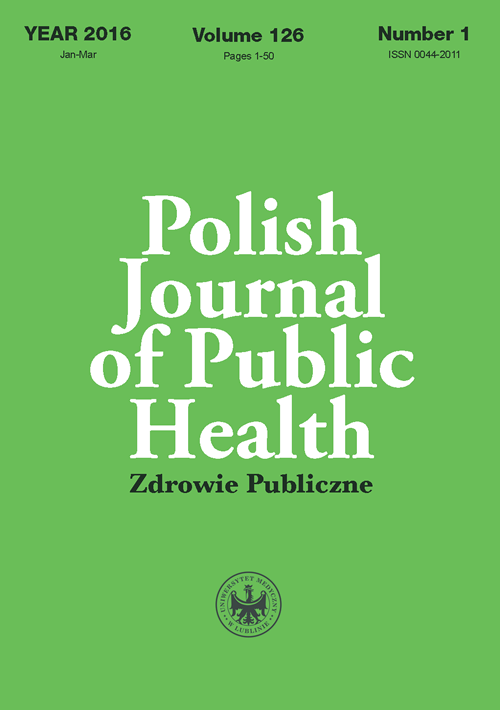Prevention of STI and teenage pregnancies through sex education
DOI:
https://doi.org/10.1515/pjph-2016-0010Keywords:
sex education, sexually transmitted infections, STI, adolescent, pregnancy, prophylaxis/preventionAbstract
Different names are used when referring to sex education, as well as there are different ways to teach the subject. Yet, it remains an essential part of the school curriculum. Using different curricula may yield various results. The content of sex education classes is dependent on various cultural and social aspects, specific to the certain country. In Poland, sex education-related topics are brought up during classes of Introduction to Family Planning, as it is called in Polish. The Ministry of Education is responsible for shaping sex education policies. The curriculum mostly focuses on STI-related diseases (including HIV/AIDS), contraceptive methods and teen pregnancy issues. Unfortunately, psychological aspects of sex or sexual assault subjects are rarely discussed upon.
As a result, sexual initiation often results in unwanted pregnancies or infections. Shame is a huge obstacle to effective communication on these topics between teens ant their parents. This shows the need for organizing educational meetings for parents or carers to help them start a conversation on this delicate subject with their kids. Sex education should be focused on presenting upright knowledge with medical accuracy, which will be an addition to the content provided by parents. Well-prepared teachers can have impact over lowering the rate of sexually transmitted infections and teenage pregnancies. Sex education has also a significant influence over promoting responsible sex and increasing teens’ awareness.
References
1. Wellings K, Parker R, Britton A. A reference guide to policies and practicies: Sex education in Europe. IPPF European Network; 2006. [http://www.laicite-laligue.org/images/PDF/IPPF_sexuality_education.pdf]
2. Federacja na Rzecz Kobiet i Planowania Rodziny. Edukacja seksualna czy Wychowanie do życia w rodzinie? Przepisy prawne i podstawa programowa. [http://www.federa.org.pl/publikacje/edukacja_seksualna_factsheet_2013.pdf]
3. Frankowicz-Gasiul B, Michalik A, Czerwińska A, et al. Ciąża młodocianych - problem medyczny i społeczny. Studia ed. 2008;11:57-63.
4. Padała O, Sadowska M, Wdowiak A, et al. Młodociane macierzyństwo jako problem medyczny i społeczny. Eur J Med Tech. 2014;2(3).
5. Gąsiorowski J, Łapiński Ł, Cichewicz A. Choroby przenoszone drogą płciową. Med Prakt. [http://dermatologia.mp.pl/choroby/wenerologia/show.html?id=80452]
6. Federal Centre for Health Education (BZgA), World Health Organization Regional Office for Europe, WHO Regional Office for Europe and BZgA Standards for Sex education in Europe Standards for Sex education in Europe; 2010. p. 10-4.
7. Planned Parenthood Federation of America Inc. Implementing Sex Education. [https://www.plannedparenthood.org/educators/implementing-sexeducation#sthash.QhFqwtTp.dpuf]
8. Campogni C. A psychological approach to sex education: Is abstinence the answer? [http://www.examiner.com/article/a-psychological-approach-tosex-education-is-abstinence-the-answer]
9. Future of Sex Education Initiative. National Sex education Standards: Core Content and Skills, K-12. A special publication of the Journal of School Health. [http://www.advocatesforyouth.org/publications/publications-az/1947-future-of-sex-education-national-sexuality-education-standards]
10. Stein R. Abstinence-only programs might work, study says. Washington: The Washington Post; 2010. [http://www.washingtonpost.com/wp-dyn/content/article/2010/02/01/AR2010020102628.html]
11. Sexuality Information and Education Council of the United States. What the Research Says. Comprehensive Sex Education. [http://www.siecus.org/index.cfm?fuseaction=Page.ViewPage&PageID=1193]
12. Kohler PK, Manhart LE, Lafferty WE. Abstinence-Only and Comprehensive Sex Education and the Initiation of Sexual Activity and Teen Pregnancy. J Adolesc Health. 2008;42(4):344-51. DOI: http://dx.doi.org/10.1016/j.jadohealth.2007.08.026.
13. National Center for HIV/AIDS, Viral Hepatitis, STD, and TB Prevention. Effective HIV and STD Prevention Programs for Youth: A Summary of Scientific Evidence. [http://www.cdc.gov/healthyyouth/sexualbehaviors/pdf/effective_hiv.pdf]
14. American Psychological Association. Based on the Research, Comprehensive Sex Education Is More Effective at Stopping the Spread of HIV Infection, Says APA Committee. [http://www.apa.org/news/press/releases/2005/02/sex-education.aspx]
15. Wilczak M, Więznowska-Mączyńska K, Kątniak M, Opala T. Antykoncepcja hormonalna wśród studentek Akademii Medycznej w Poznaniu. Prz Ginekol Położ. 2006;6(3):143-8.
16. Instytut Badań Edukacyjnych. Opinie i oczekiwania młodych dorosłych (18 latków) oraz rodziców dzieci w wieku 6-17 lat wobec edukacji seksualnej dotyczącej rozwoju psychoseksualnego i seksualności. [https://men.gov.pl/wp-content/uploads/2015/07/ekd_prezentacja_men_20150617_1310.pdf]
17. Wejbert-Wąsiewicz E. Aborcja – między ideologią a doświadczeniem indywidualnym. Monografia zjawiska. Łódź: Wydawnictwo UŁ; 2010. p.110-2.
18. Józefowska A, Kołacka M. Raport Grupy Edukatorów Seksualnych Ponton: Jak naprawdę wygląda edukacja seksualna w Polsce? [http://ponton.org.pl/sites/ponton/files/raport_jaka_edukacja_seksualna_grupa_ponton_2009.pdf]
19. Adolescence Committee on Psychosocial Aspects of Child and Family Health and Committee on Adolescence. Sexuality education for Children and Adolescents. Pediatrics. 2001;108;498-502.
20. Kirby DB, Laris BA, Rolleri LA. Sex and HIV Education Programs: Their Impact on Sexual Behaviors of Young People Throughout the World. J Adol Health. 2007;40:206-17.
21. United Nations Educational, Scientific and Cultural Organization. Sexuality education. [http://www.unesco.org/new/en/hiv-and-aids/our-priorities-in-hiv/sexuality-education/]
22. Santelli JS. Medical Accuracy in Sex education: Ideology and the Scientific Process. Am J Public Health. 2008;98(10):1786-92.
23. United Nations Population Fund. The Evaluation of Comprehensive Sexuality education Programmes: A Focus on the Gender and Empowerment Outcomes. [http://www.unfpa.org/sites/default/files/pub-pdf/UNFPAE-valuationWEB4.pdf]
24. Monbiot G. Joy of sex education. The Guardian News and Media Limited; 2011. [http://www.theguardian.com/education/2004/may/11/schools.uk2]
Downloads
Published
Issue
Section
License
Copyright (c) 2016 Polish Journal of Public Health

This work is licensed under a Creative Commons Attribution-NonCommercial-NoDerivatives 3.0 Unported License.


